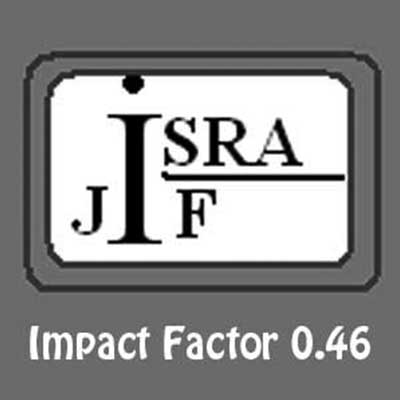 JADD.IN
JADD.IN
Journal of Advanced Drug Delivery
Journal of Advanced Drug Delivery (www.jadd.in) is Bimonthly published online journal, which publish innovative Research Paper, Reviews, Short Communication and Book Reviews. Journal of Advanced Drug Delivery (JADD) publishes the research in the design, development, manufacture, and evaluation of traditional and novel drug delivery systems, emphasizing practical solutions and applications to theoretical and research-based problems, through basic and applied research articles, review papers, short reports, and book reviews. Journal of Advanced Drug Delivery (JADD) covers topics such as: preformulation evaluation of pharmaceutical materials physical pharmacy and formulation research process engineering and scale-up of drug delivery systems drug delivery systems? evaluation and quality improvement global standardization of pharmaceutical information. Manuscripts with multi-authors imply the consent of each of the authors. The publisher will presume that the corresponding author has specifically obtained the approval of all other co-authors to submit the article to JADD. Submission of an article to JADD is understood to imply that it has not been either published or not being considered for publication elsewhere.
Each manuscript should be neatly typed, single-spaced throughout; including tables, graphs, figures etc. Manuscript should be uniform size with at least 2.5cm margin on all sides. . Prepare the manuscript in Times New Roman font using a font size of 12. Title shall be in a font size 14, bold face capitals. All section titles in the manuscript shall be in font size 12, bold face capitals. Subtitles in each section shall be in font size 12, bold face lower case. Standard International Units could be used throughout the text. Pages should not be numbered, manuscript should be starting with the title page and the text should be arranged in the following order:
- Title page
- Abstract
- Key words
- Introduction
- Materials and Methods
- Results and Discussion
- Conclusion
- Acknowledgements
- References
The abstract with keywords should be typed on a separate sheet. The abstract should not more than 250 words and should present the reason of study, the main findings and principal conclusion. Abstract should not be structured. Abstract must be followed by four-six keywords.
Should start on a new page and should clearly indicate the aim of the study. The introduction should not be an extensive review of the literature but should refer only to previous work which has a direct bearing on the topic to be discussed.
The section Materials and Methods should include concise details on the methodology adopted, sufficient to repeat the experiment. Please provide concise but complete information about the material and the analytical, statistical and experimental procedures used. The statistical method and the level of significance chosen should be clearly stated. In case of animal experiments authors must give the details of ethical approval.
Data acquired from the research with appropriate statistical analysis described in the methods section should be included in this section. All results presented in tabular or graphical form shall be described in this section. Should contain a critical review of the results of the study with the support of relevant literature. Discussion should relate the results to current understanding of the scientific problems being investigated in the field.
In a separate section, the major findings of the study and their usefulness shall be summarized. This paragraph should address the main conclusions of the work highlighting its importance and relevance.
All acknowledgments should be typed in one paragraph directly preceding the reference section and may include supporting grants, presentations, and so forth.
The authors are responsible for the accuracy of the bibliographic information. The references should be listed on a separate sheet and should be numbered consecutively in the order in which they are cited in the text. Cite in the text by the appropriate Arabic number e.g. 1, 2, 3 and the numbers should be superscripted. The commonly cited types of references are shown below, for other types of references such as electronic media, newspaper items, etc. please refer to ICMJE Guidelines (http://www.icmje.org).
Wright CI, Van-Buren L, et al "Herbal medicines as diuretics: a review of the scientific evidence " J Ethnopharmacol, 2007,114 (1): 1 - 31.
Parrot EL, Lachman L, Libermann HA and Kanig JL, Theory and Practice of Industrial Pharmacy, 3rd edition, Lea and Febiger, Philiadelphia, 1986, 21.
All the tables and figures should be in the text at suitable place
Tables
Each table should have a short, descriptive title and numbered in the order (using Arabic numerals) cited in the text. Abbreviations should be defined as footnotes in italics at the bottom of each table. Please do not duplicate material that is already presented in the tables.
Table Format - Exactly same as below
Table - 1:Title
|
A |
B |
C |
D |
|
1 |
12.18 ± 0.1 |
100.01 ± 0.23
|
77.5 ± 0.55 |
|
2 |
100.01 ± 0.23 |
6.90 ± 1.25 * |
34.12 |
|
3 |
55.01 ± 0.23 |
16.1±1.24 * |
45.61 |
|
4 |
16.1±1.24 |
10.7±1.45 * |
63.85 |
Values are expressed as mean±SEM (Standard Error Mean); * indicates P < 0.001, one-way ANOVA followed by Dunnet’s test as compared to control; n = Number of mice; p.o.: per oral.
Figures (photographs, drawings, diagrams and charts) are to be numbered in one consecutive series of the Arabic numerals in the order in which they are cited in the text and abbreviated as Fig.X.Photos or drawings must have a good contrast of dark and light. Legends of figures should be brief, but complete and self- explanatory so that the reader can easily understand the results presented in the figure.
Standard abbreviations should be used throughout the manuscript. All nonstandard abbreviations should be kept to a minimum and must be defined in the text following their first use.
The journal publishes exciting findings, preliminary data or studies that did not yield enough information to make a full paper as short communications. These have the same format requirements as full papers but are only up to 9 pages in length. Short Communications should not have subtitles such as Introduction, Materials and Methods, Results and Discussion - all these have to be merged into the running text. Short Communications preferably should have only 3-4 illustrations.
Should be about 18 pages long, contain up-to-date information, comprehensively cover relevant literature and preferably be written by scientists who have in-depth knowledge on the topic. All format requirements are same as those applicable to full papers. Review articles need not be divided into sections such as Materials and Methods and Results and Discussion, but should definitely have an Abstract and Introduction, if necessary.
Plagiarism is a serious issue around the world in the arena of manuscript writing. Plagiarism means "Use or close imitation of the language and thoughts of another author and the representation of them as one's own original work." It has been noticed that, authors are simply copying scientific data and information from the other published papers, which is unlawful practice in academic fraternity. Therefore, I request to the all authors please adopt the holistic & pragmatic approach to design the manuscript of interest.
JADD will not be responsible for further action on Plagiarism issue. The author will be solely responsible for plagiarism issue. .
Submission is a representation that the manuscript has not been published previously and is not under consideration for publication elsewhere. Authors would be required to sign a form (COPYRIGHT FORM) transferring copyright before the manuscript can be published.
Manuscript should be submitted online along with a scanned copy of duly signed copy right form by mailing at following Email ID: editorjadd@gmail.com || editor@jadd.in
Decision on your article will be taken once we receive comments from reviewers and this duration will not exceed more than 07 days.
No responsibility is assumed by the JADD (Publisher or its staff or members of the editorial board) for any injury and/or damage to persons or property as a matter of products liability, negligence or otherwise, or from any use or operation of any methods, products, instructions or ideas contained in the material herein. The respective individual author(s) are responsible for the facts and views expressed in their articles.

Journal of Advanced Drug Delivery by Mr.Mukesh Shinde is licensed under a Creative Commons Attribution-NonCommercial-NoDerivatives 4.0 International License . Based on a work at www.jadd.in .


